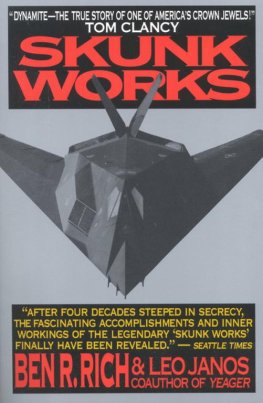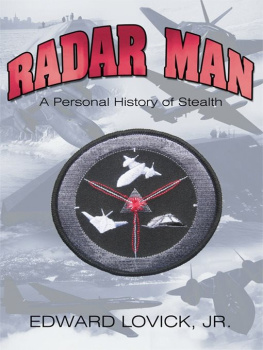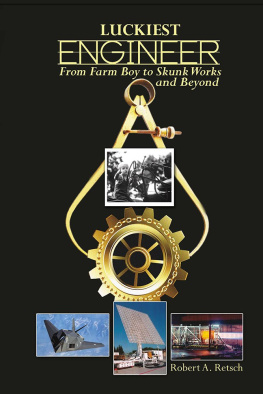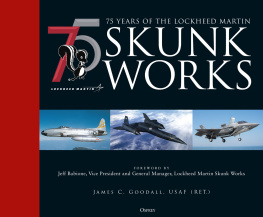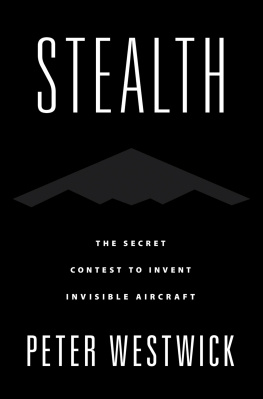Ben R. Rich and Leo Janos
SKUNK WORKS
A Personal Memoir of My Years at Lockheed
To the men and women of the Skunk Works, past, present, and future

THE AUTHORS wish to acknowledge the contributions of various friends, co-workers, and former colleagues who enriched the pages of this book with their perspectives and recollections. Special thanks to Nancy Johnson and to Lockheeds CEO, Dan Tellep, for providing access to Kelly Johnsons logbooks and to former colleagues Sherm Mullin, Jack Gordon, Ray Passon, Dennis Thompson, Willis Hawkins, and Steve Shobert, who provided their expertise and advice through the manuscript process. Thanks also to Col. (ret.) Barry Hennessey, Pete Eames, Air Force historian Richard Hallion, and Don Welzenbach of the CIA.
Numerous Skunk Workers contributed their insights and memories. Among them: Dick Abrams, Ed Baldwin, Alan Brown, Buddy Brown, Norb Budzinske, Fred Carmody, Henry Combs, Jim Fagg, Bob Fisher, Tom Hunt, Bob Klinger, Alan Land, Tony LeVier, Red McDaris, Bob Murphy, Norm Nelson, Denys Overholser, Bill Park, Tom Pugh, Jim Ragsdale, Butch Sheffield, Steven Schoenbaum, and Dave Young.
We are particularly grateful for the participation of Air Force and CIA pilots, past and present: Bob Belor, Tony Bevacqua, William Burk Jr., Jim Cherbonneaux, Buz Carpenter, Ron Dyckman, Barry Horne, Joe Kinego, Marty Knutson, Joe Matthews, Miles Pound, Randy Elhorse, Jim Wadkins, Al Whitley, and Ed Yeilding. Significant too were the contributions of the current secretary of defense, William J. Perry, and former secretaries, Donald H. Rumsfeld, James R. Schlesinger, Harold Brown, and Caspar Weinberger; also former Chairman of the Joint Chiefs of Staff General David Jones, former Air Force Secretary Don Rice, the CIAs Richard Helms, Richard Bissell, John McMahon, Albert Bud Wheelon, and John Parangosky; Generals Leo Geary, Larry Welch, Jack Ledford, and Doug Nelson; National Security advisers Walt Rostow and Zbigniew Brzezinski, and Albert Wohlstetter, formerly of the Presidents Foreign Intelligence Advisory Board.
For obtaining photos and reference sources, appreciation to Lockheeds Denny Lombard and Eric Schulzinger, Bill Lachman and Bill Working of the Central Imaging Office, Jay Miller of Aerofax, and Tony Landis. For reference material, a salute to aviation writers Chris Pocock and Paul Crickmore.
For help often above and beyond the call of duty, our gratitude to Diana Law, Myra Gruenberg, Debbie Elliot, Karen Rich, Bert Reich, Ben Cate, and in particular to my son, Michael Rich, for his insights and suggestions, and to our wives, Hilda Rich and Bonnie Janos, for their patience and support.
Finally, our affectionate appreciation to our agent, Kathy Robbins, and to our editor, Fredrica Friedman, executive editor of Little, Brown.
Los Angeles, January 1994
Its August 1979 on the scorching Nevada desert, where Marines armed with ground-to-air Hawk missiles are trying to score a kill against my new airplane, an experimental prototype code-named Have Blue. We in the Skunk Works have built the worlds first pure stealth fighter, which is designed to evade the Hawks powerful radar tracking. The Marines hope to find Have Blue from at least fifty miles away and push all the right buttons so that the deadly Hawks will lock on. To help them, Ive actually provided Have Blues flight plan to the missile crew, which is like pointing my finger at a spot in the empty sky and saying, Aim right here. All theyve got to do is acquire the airplane on radar, and the homing system inside the Hawk missile will do the rest. Under combat conditions, that airplane would be blasted to pieces. If that defensive system locks on during this test, our experimental airplane flunks the course.
But Im confident that our stealth technology will prove too elusive for even this Hawk missiles powerful tracking system (capable of detecting a live hawk riding on the thermals from thirty miles away). What makes this stealth airplane so revolutionary is that it will deflect radar beams like a bulletproof shield, and the missile battery will never electronically see it coming. On the Hawks tracking system, our fighters radar profile would show up as smaller than a hummingbirds. At least, thats what Im betting. If Im wrong, Im in a hell of a bind.
Half the Pentagons radar experts think we at the Skunk Works have achieved a stealth technology breakthrough that will revolutionize military aviation as profoundly as the first jets did. The other half thinks we are deluding ourselves and everyone else with our radar test claims. Those cynics insist that we are trying to pull a fast onethat well never be able to duplicate on a real airplane the spectacular low visibility we achieved on a forty-foot wooden model of Have Blue, sitting atop a pole on a radar test range. Those results blew away most of the Air Force command staff. So this demonstration against the Hawk missile is the best way I know to shut up the nay-sayers definitively. This test is In your face, buddy, to those bad-mouthing our technology and our integrity. My test pilot teased me that Vegas was giving three to two odds on the Hawk over Have Blue. But what do those damned bookies know? he added with a smirk, patting my back reassuringly.
Because our stealth test airplane has been under the tightest security, weve had to deceive the Marines into thinking that the only thing secret about our airplane is a black box its supposed to be carrying in its nose that emits powerful beams to deflect incoming radar. Of course, thats all bogus. No such black box aboard, no beams involved. The invisibility comes entirely from the airplanes shape and its radar-absorbing composite materials.
The missile crew will monitor the test on their radar scope inside their windowless command van, but a young sergeant standing beside me will be able to verify that, despite the blank screen, an airplane indeed flew overhead. God knows what he will think seeing our airplane in the sky, a weird diamond-shaped UFO, looking as if it escaped from a trailer for a new George Lucas Star Wars epic.
I check my watch. Eight in the morning. The temperature already in the nineties, heading toward a predicted high of one-twenty F. Have Blue should be well inside the missiles radar track, heading for us. And in a few moments I spot a distant speck growing ever larger in the milky blue sky. I watch Have Blue through my binoculars as it flies at eight thousand feet. The T-38 chase plane, which usually flies on its wing in case Have Blue develops problems and needs talking down to a safe landing, is purposely following miles behind for this test. The radar dish atop the van hasnt moved, as if the power has been turned off. The cluster of missiles, which normally would be swiveling in the launcher, locked on by radar to the approaching target, are instead pointing aimlessly (and blindly) toward distant mountains. The young sergeant stares in disbelief at the sightless missiles, then gapes as the diamond-shaped aircraft zips by directly above us. God almighty, he exclaims, whatever that thing was, sir, it sure is carrying one hell of a powerful black box. You jammed us dead.
Looks that way. I say and grin.
I head to the command van, and a cold blast of the air-conditioning greets me as I step inside. The Marine crew is still seated around their electronic gear with stolid determination. Their scope screen is empty. Theyre waiting. As far as they know, nothing has yet flown into their radar net. Suddenly a blip appears. Its moving quickly west to east in the exact coordinates of Have Blue.

